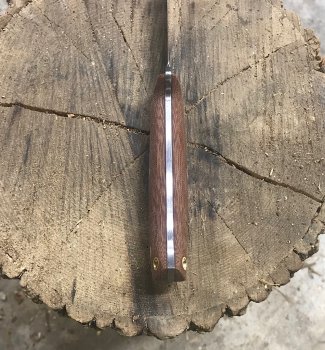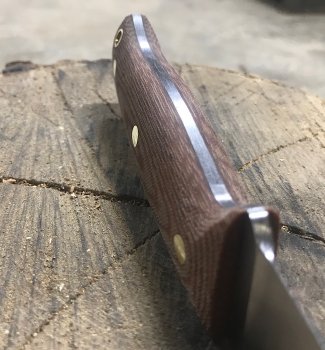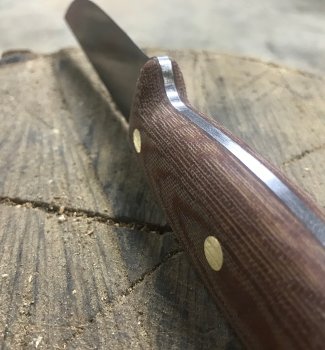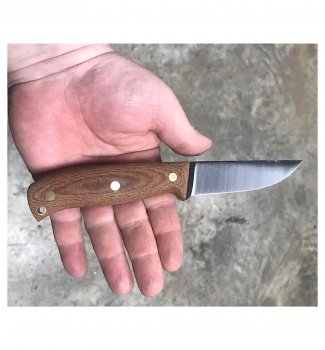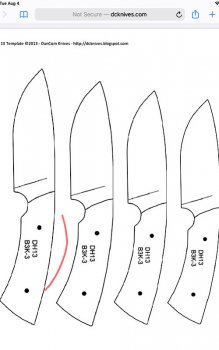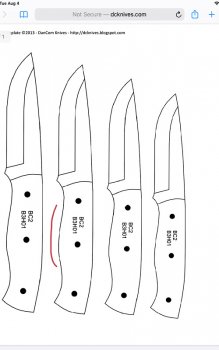You are using an out of date browser. It may not display this or other websites correctly.
You should upgrade or use an alternative browser.
You should upgrade or use an alternative browser.
Thoughts on handle designs.
- Thread starter Mark Barone
- Start date
tkroenlein
Well-Known Member
IMO, one of those would make a great hunter, and one would make a great bushcrafter, and frustrate the user for the other purpose. Also, heavily curved or finger grooved handles are much more sensitive to grip position than less featured handles. Remember the humble Old Hickory.
Randy Lucius
Well-Known Member
I can’t offer much on handle design theory but I’ve made a couple of knives from that first template and I liked them very much. Felt good in hand.
chrisstaniar
Well-Known Member
For hunting knives, I base my preferences off of my experience processing game both in the field and back at the "ranch" doing the final "disassembly" of the critter. I prefer a drop point, bigger bellied knife blade, with a "belly" on the handle. It just feels better in my hand. Same goes for a slight narrowing of the handle near the back of the knife but having it widen at the end. To me it makes it easier to grip the knife and less tiring for the hand.
Less tiring is important when working on an elk.
Less tiring is important when working on an elk.
EdCaffreyMS
"The Montana Bladesmith"
Whatever the details, knife handles SHOULD, first and foremost, be designed to fit the human hand....and not just in one way of gripping it, but in every way you can image. To that end, here are what I consider "hard and fast" rules of knife handles, and the reason(s).....
First, look at the human hand, and how it closes around any object grasped..... the smallest area of the "grip" is where the thumb and index finger come together.... and the largest/most open area of the grip is the heel/pinky finger area of the hand. This means that a knife handle should be smaller/narrower in the front, and larger/wider/taller at the rear of the handle. From there a maker can do any number of things, but, no matter what else or how else you do anything to a knife handle, if you fail to follow the basic "smaller in the front and larger in the back" rule, the handle simply will not "fit" well, nor does it feel "right".
The single biggest mistake I see in newer makers is handle design/creation. Many tend to make the rear of a handle small and narrow, and the front large and wide. Another thing that should always be in a makers mind is sharp angles/edges.....neither have any place on a knife handle.
This is way over simplifying it, but if you can whittle a 2x4 in half with a given knife, and not have blisters in the end....you've produced a "comfortable" knife handle.
As to the original question..... Various knives, particularly factory/production knives have handles that are designed in favor of ease of production rather than comfort of the end user. That means IF a maker looks to production/factory knives for handle design input/inspiration....it's very likely you shouldn't be, and it will generally guide you down the wrong path.
This often bleeds over to new makers, because they do not have any other example(s) to follow, nor do they yet posses enough knowledge to understand applying ergonomics to knife handles. In fact I know of a number of "custom" knifemakers, who have been at it a LONG time, and still haven't figured out how to produce a comfortable/user friendly knife handle.
One HUGE REASON that we see a lot of poorly made/uncomfortable knife handles these days is due to many using CAD software to design knives....again, particularly newer makers. That's because the newer makers still don't have enough experience to understand the ergonomics of a knife handle, but also because CAD software lends itself to angles more than curves. Again, don't get me wrong, CAD has it's place and so do "patterns", but as with anything, when they are relied on too much, or exclusively, they become a hindrance, rather then an asset.
First, look at the human hand, and how it closes around any object grasped..... the smallest area of the "grip" is where the thumb and index finger come together.... and the largest/most open area of the grip is the heel/pinky finger area of the hand. This means that a knife handle should be smaller/narrower in the front, and larger/wider/taller at the rear of the handle. From there a maker can do any number of things, but, no matter what else or how else you do anything to a knife handle, if you fail to follow the basic "smaller in the front and larger in the back" rule, the handle simply will not "fit" well, nor does it feel "right".
The single biggest mistake I see in newer makers is handle design/creation. Many tend to make the rear of a handle small and narrow, and the front large and wide. Another thing that should always be in a makers mind is sharp angles/edges.....neither have any place on a knife handle.
This is way over simplifying it, but if you can whittle a 2x4 in half with a given knife, and not have blisters in the end....you've produced a "comfortable" knife handle.
As to the original question..... Various knives, particularly factory/production knives have handles that are designed in favor of ease of production rather than comfort of the end user. That means IF a maker looks to production/factory knives for handle design input/inspiration....it's very likely you shouldn't be, and it will generally guide you down the wrong path.
This often bleeds over to new makers, because they do not have any other example(s) to follow, nor do they yet posses enough knowledge to understand applying ergonomics to knife handles. In fact I know of a number of "custom" knifemakers, who have been at it a LONG time, and still haven't figured out how to produce a comfortable/user friendly knife handle.
One HUGE REASON that we see a lot of poorly made/uncomfortable knife handles these days is due to many using CAD software to design knives....again, particularly newer makers. That's because the newer makers still don't have enough experience to understand the ergonomics of a knife handle, but also because CAD software lends itself to angles more than curves. Again, don't get me wrong, CAD has it's place and so do "patterns", but as with anything, when they are relied on too much, or exclusively, they become a hindrance, rather then an asset.
Last edited:
Jesse Latham
Well-Known Member
You may find this interesting.
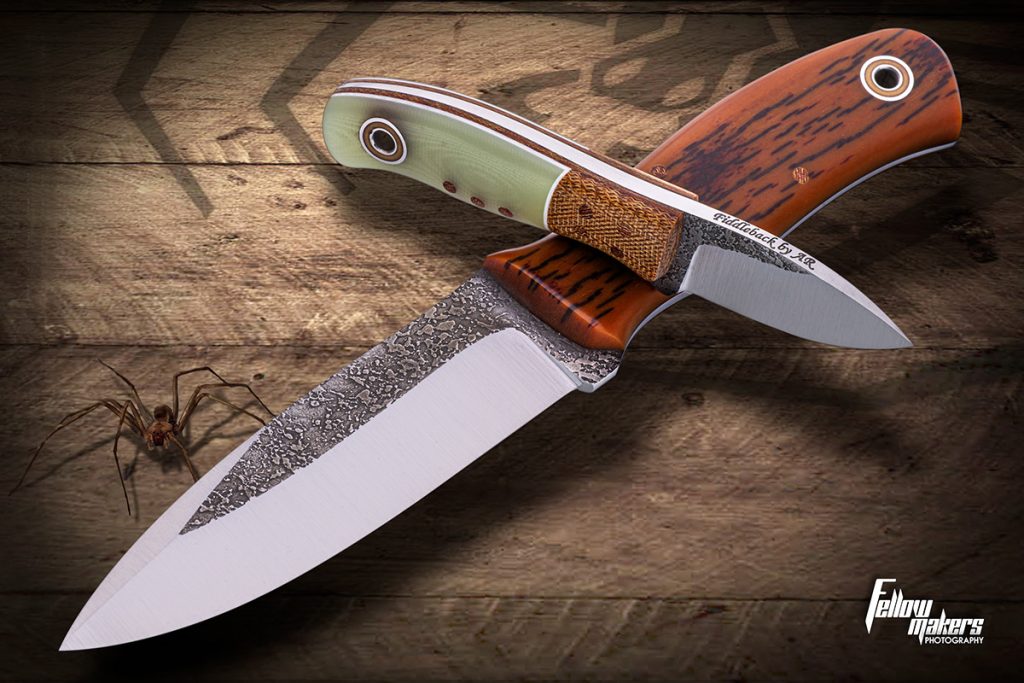
 knife-gear.com
knife-gear.com

Get a Grip
Pro Tips for Properly Shaping the Interface Between Flesh and Steel Story by Andy RoyPhotos by Andy Roy, Eric Eggly, Fiddleback Outpost and Fellow Makers Photography When I started making knives, I go
Mark Barone
Well-Known Member
Whatever the details, knife handles SHOULD, first and foremost, be designed to fit the human hand....and not just in one way of gripping it, but in every way you can image. To that end, here are what I consider "hard and fast" rules of knife handles, and the reason(s).....
First, look at the human hand, and how it closes around any object grasped..... the smallest area of the "grip" is where the thumb and index finger come together.... and the largest/most open area of the grip is the heel/pinky finger area of the hand. This means that a knife handle should be smaller/narrower in the front, and larger/wider/taller at the rear of the handle. From there a maker can do any number of things, but, no matter what else or how else you do anything to a knife handle, if you fail to follow the basic "smaller in the front and larger in the back" rule, the handle simply will not "fit" well, nor does it feel "right".
The single biggest mistake I see in newer makers is handle design/creation. Many tend to make the rear of a handle small and narrow, and the front large and wide. Another thing that should always be in a makers mind is sharp angles/edges.....neither have any place on a knife handle.
This is way over simplifying it, but if you can whittle a 2x4 in half with a given knife, and not have blisters in the end....you've produced a "comfortable" knife handle.
As to the original question..... Various knives, particularly factory/production knives have handles that are designed in favor of ease of production rather than comfort of the end user. That means IF a maker looks to production/factory knives for handle design input/inspiration....it's very likely you shouldn't be, and it will generally guide you down the wrong path.
This often bleeds over to new makers, because they do not have any other example(s) to follow, nor do they yet posses enough knowledge to understand applying ergonomics to knife handles. In fact I know of a number of "custom" knifemakers, who have been at it a LONG time, and still haven't figured out how to produce a comfortable/user friendly knife handle.
One HUGE REASON that we see a lot of poorly made/uncomfortable knife handles these days is due to many using CAD software to design knives....again, particularly newer makers. That's because the newer makers still don't have enough experience to understand the ergonomics of a knife handle, but also because CAD software lends itself to angles more than curves. Again, don't get me wrong, CAD has it's place and so do "patterns", but as with anything, when they are relied on too much, or exclusively, they become a hindrance, rather then an asset.
thos was very helpfulEd. You are an amazing teacher. Given that. I am making simple bushcraft knife and will apply these principles to the handle, instead of my usual “ 2 dimensional” Type handle. Stay tuned.
billyO
Well-Known Member
Here's another interesting article on handle design and ergonomics:
 versteegblades.com
versteegblades.com
versteegblades.com - versteegblades Resources and Information.
versteegblades.com is your first and best source for all of the information you’re looking for. From general topics to more of what you would expect to find here, versteegblades.com has it all. We hope you find what you are searching for!
 versteegblades.com
versteegblades.com
Mark Barone
Well-Known Member
Thanks Billy. Also very helpful. I knew nothing about ergonomics when I was a butcher 20 years. My table was too high because I’m short, my handle wasn’t good. I have had multiple shoulder and hand surgeries since then. I can easily tie it bad ergonomics at the time.Here's another interesting article on handle design and ergonomics:
versteegblades.com - versteegblades Resources and Information.
versteegblades.com is your first and best source for all of the information you’re looking for. From general topics to more of what you would expect to find here, versteegblades.com has it all. We hope you find what you are searching for!versteegblades.com
tkroenlein
Well-Known Member
If you were a butcher for 20 years, you know more about handles than any 20 knife makers.Thanks Billy. Also very helpful. I knew nothing about ergonomics when I was a butcher 20 years. My table was too high because I’m short, my handle wasn’t good. I have had multiple shoulder and hand surgeries since then. I can easily tie it bad ergonomics at the time.
tkroenlein
Well-Known Member
Here are my thoughts on "bushcraft" handles. My own design is very similar to your bottom pic. The thing I don't personally like about that bottom pic is where the scales stop. That uncovered bit of metal "finger guard" was a hot spot. No issues after covering up. These pics are of my first "worked out" handle. I left the scales and profile oversized and ground to relieve hot spots as they presented.
